The Strengthened Photocatalytic NOx Removal of Composites Bi4O5Br2/BiPO4: The Efficient Regulation of Interface Carriers by Integrating a Wide-Bandgap Ornament
Abstract
:1. Introduction
2. Results and Discussion
2.1. Microstructural and Morphological Characterization
2.2. Photocatalytic NOx Removal Measurements
2.3. Photocatalytic Mechanism Deduction
3. Materials and Methods
3.1. Materials’ Preparation and Characterization
3.2. Photocatalytic Capability Estimation and Reactive Species’ Recognition
4. Conclusions
Supplementary Materials
Author Contributions
Funding
Institutional Review Board Statement
Informed Consent Statement
Data Availability Statement
Conflicts of Interest
Sample Availability
References
- Zhai, S.; Jacob, D.J.; Wang, X.; Liu, Z.; Wen, T.; Shah, V.; Li, K.; Moch, J.M.; Bates, K.H.; Song, S.; et al. Control of particulate nitrate air pollution in China. Nat. Geosci. 2021, 14, 389–395. [Google Scholar] [CrossRef]
- Boningari, T.; Smirniotis, P.G. Impact of nitrogen oxides on the environment and human health: Mn-based materials for the NOx abatement. Curr. Opin. Chem. Eng. 2016, 13, 133–141. [Google Scholar] [CrossRef]
- Gholami, Z.; Luo, G.; Gholami, F.; Yang, F. Recent advances in selective catalytic reduction of NOx by carbon monoxide for flue gas cleaning process: A review. Catal. Rev. 2020, 63, 68–119. [Google Scholar] [CrossRef]
- Nguyen, V.-H.; Nguyen, B.-S.; Huang, C.-W.; Le, T.-T.; Nguyen, C.C.; Nhi Le, T.T.; Heo, D.; Ly, Q.V.; Trinh, Q.T.; Shokouhimehr, M.; et al. Photocatalytic NOx abatement: Recent advances and emerging trends in the development of photocatalysts. J. Clean. Prod. 2020, 270, 121912. [Google Scholar] [CrossRef]
- Zhou, X.; Zhang, J.; Wang, X.; Tan, T.; Fang, R.; Chen, S.; Dong, F. Efficient NO removal and photocatalysis mechanism over Bi-metal@Bi2O2[BO2(OH)] with oxygen vacancies. J. Hazard. Mater. 2022, 436, 129271. [Google Scholar] [CrossRef] [PubMed]
- Lasek, J.; Yu, Y.-H.; Wu, J.C.S. Removal of NOx by photocatalytic processes. J. Photoch. Photobi. C 2013, 14, 29–52. [Google Scholar] [CrossRef]
- Chang, F.; Wang, X.; Yang, C.; Li, S.; Wang, J.; Yang, W.; Dong, F.; Hu, X.; Liu, D.-g.; Kong, Y. Enhanced photocatalytic NO removal with the superior selectivity for NO2−/NO3− species of Bi12GeO20-based composites via a ball-milling treatment: Synergetic effect of surface oxygen vacancies and n-p heterojunctions. Compos. Part B Eng. 2022, 231, 109600. [Google Scholar] [CrossRef]
- Chang, F.; Lei, B.; Yang, C.; Wang, J.; Hu, X. Ultra-stable Bi4O5Br2/Bi2S3 n-p heterojunctions induced simultaneous generation of radicals ·OH and ·O2− and NO conversion to nitrate/nitrite species with high selectivity under visible light. Chem. Eng. J. 2021, 413, 127443. [Google Scholar] [CrossRef]
- Mao, D.; Yuan, J.; Qu, X.; Sun, C.; Yang, S.; He, H. Size tunable Bi3O4Br hierarchical hollow spheres assembled with {0 0 1}-facets exposed nanosheets for robust photocatalysis against phenolic pollutants. J. Catal. 2019, 369, 209–221. [Google Scholar] [CrossRef]
- Chang, F.; Yang, C.; Wang, J.; Lei, B.; Li, S.; Kim, H. Enhanced photocatalytic conversion of NOx with satisfactory selectivity of 3D-2D Bi4O5Br2-GO hierarchical structures via a facile microwave-assisted preparation. Sep. Purif. Technol. 2021, 266, 11237. [Google Scholar] [CrossRef]
- Li, P.; Zhou, Z.; Wang, Q.; Guo, M.; Chen, S.; Low, J.; Long, R.; Liu, W.; Ding, P.; Wu, Y.; et al. Visible-light-driven nitrogen fixation catalyzed by Bi5O7Br nanostructures: Enhanced performance by oxygen vacancies. J. Am. Chem. Soc. 2020, 142, 12430–12439. [Google Scholar] [CrossRef] [PubMed]
- Di, J.; Song, P.; Zhu, C.; Chen, C.; Xiong, J.; Duan, M.; Long, R.; Zhou, W.; Xu, M.; Kang, L.; et al. Strain-engineering of Bi12O17Br2 nanotubes for boosting photocatalytic CO2 reduction. ACS Mater. Lett. 2020, 2, 1025–1032. [Google Scholar] [CrossRef]
- Cheng, H.; Huang, B.; Dai, Y. Engineering BiOX (X = Cl, Br, I) nanostructures for highly efficient photocatalytic applications. Nanoscale 2014, 6, 2009–2026. [Google Scholar] [CrossRef] [PubMed]
- Li, J.; Yu, Y.; Zhang, L. Bismuth oxyhalide nanomaterials: Layered structures meet photocatalysis. Nanoscale 2014, 6, 8473–8488. [Google Scholar] [CrossRef] [PubMed]
- Chang, F.; Yan, W.; Wang, X.; Peng, S.; Li, S.; Hu, X. Strengthened photocatalytic removal of bisphenol a by robust 3D hierarchical n-p heterojunctions Bi4O5Br2-MnO2 via boosting oxidative radicals generation. Chem. Eng. J. 2022, 428, 131223. [Google Scholar] [CrossRef]
- Zhu, G.; Hojamberdiev, M.; Zhang, W.; Taj Ud Din, S.; Joong Kim, Y.; Lee, J.; Yang, W. Enhanced photocatalytic activity of Fe-doped Bi4O5Br2 nanosheets decorated with Au nanoparticles for pollutants removal. Appl. Surf. Sci. 2020, 526, 146760. [Google Scholar] [CrossRef]
- Chang, F.; Li, S.; Shi, Z.; Qi, Y.; Liu, D.-g.; Liu, X.; Chen, S. Boosted photocatalytic NO removal performance by S-scheme hierarchical composites WO3/Bi4O5Br2 prepared through a facile ball-milling protocol. Sep. Purif. Technol. 2021, 278, 119662. [Google Scholar] [CrossRef]
- Chang, F.; Wang, X.; Zhao, S.; Zhang, X.; Hu, X. Fabrication of Bi12GeO20/Bi2S3 hybrids with surface oxygen vacancies by a facile CS2-mediated manner and enhanced photocatalytic performance in water and saline water. Sep. Purif. Technol. 2022, 287, 120532. [Google Scholar] [CrossRef]
- Li, S.; Cai, M.; Wang, C.; Liu, Y.; Li, N.; Zhang, P.; Li, X. Rationally designed Ta3N5/BiOCl S-scheme heterojunction with oxygen vacancies for elimination of tetracycline antibiotic and Cr(VI): Performance, toxicity evaluation and mechanism insight. J. Mater. Sci. Technol. 2022, 123, 177–190. [Google Scholar] [CrossRef]
- Liu, H.; Mei, H.; Li, S.; Pan, L.; Jin, Z.; Zhu, G.; Cheng, L.; Zhang, L. Rational design of n-Bi12TiO20@p-BiOI core-shell heterojunction for boosting photocatalytic NO removal. J. Colloid Interf. Sci. 2022, 607, 242–252. [Google Scholar] [CrossRef]
- Li, S.; Zhu, G.; Jia, Y.; Pan, L.; Nie, J.; Rao, F.; Gao, J.; Zhang, F.; Kwon, N.; Liu, C. TiO2 with exposed (001) facets/Bi4O5Br2 nanosheets heterojunction with enhanced photocatalytic for NO removal. Nanotechnology 2020, 31, 254002. [Google Scholar] [CrossRef] [PubMed]
- Yang, X.; Yang, H.; Lu, H.; Ding, H.; Tong, Y.; Rao, F.; Zhang, X.; Shen, Q.; Gao, J.; Zhu, G. 2D/2D Ti3C2/Bi4O5Br2 nanosheet heterojunction with enhanced visible light photocatalytic activity for NO removal. Acta Phys. Chim. Sin. 2020, 37, 2005008. [Google Scholar] [CrossRef]
- Zhu, G.; Li, S.; Gao, J.; Zhang, F.; Liu, C.; Wang, Q.; Hojamberdiev, M. Constructing a 2D/2D Bi2O2CO3/Bi4O5Br2 heterostructure as a direct Z-scheme photocatalyst with enhanced photocatalytic activity for NOx removal. Appl. Surf. Sci. 2019, 493, 913–925. [Google Scholar] [CrossRef]
- Li, H.; Zhu, H.; Shi, Y.; Shang, H.; Zhang, L.; Wang, J. Vacancy-rich and porous NiFe-layered double hydroxide ultrathin nanosheets for efficient photocatalytic NO oxidation and storage. Environ. Sci. Technol. 2022, 56, 1771–1779. [Google Scholar] [CrossRef]
- Rao, F.; Zhu, G.; Zhang, W.; Xu, Y.; Cao, B.; Shi, X.; Gao, J.; Huang, Y.; Huang, Y.; Hojamberdiev, M. Maximizing the formation of reactive oxygen species for deep oxidation of NO via manipulating the oxygen-vacancy defect position on (BiO)2CO3. ACS Catal. 2021, 11, 7735–7749. [Google Scholar] [CrossRef]
- Kumar, R.; Raizada, P.; Khan, A.A.P.; Nguyen, V.-H.; Van Le, Q.; Ghotekar, S.; Selvasembian, R.; Gandhi, V.; Singh, A.; Singh, P. Recent progress in emerging BiPO4-based photocatalysts: Synthesis, properties, modification strategies, and photocatalytic applications. J. Mater. Sci. Technol. 2022, 108, 208–225. [Google Scholar] [CrossRef]
- Yu, C.; Chen, X.; Li, N.; Zhang, Y.; Li, S.; Chen, J.; Yao, L.; Lin, K.; Lai, Y.; Deng, X. Ag3PO4-based photocatalysts and their application in organic-polluted wastewater treatment. Environ. Sci. Pollut. Res. 2022, 29, 18423–18439. [Google Scholar] [CrossRef]
- Bai, J.; Yang, Y.; Hu, X.; Lu, P.; Fu, M.; Ren, X. Fabrication of novel organic/inorganic polyimide-BiPO4 heterojunction for enhanced photocatalytic degradation performance. J. Colloid Interf. Sci. 2022, 625, 512–520. [Google Scholar] [CrossRef]
- Wang, X.; Wang, X.; Tian, W.; Meng, A.; Li, Z.; Li, S.; Wang, L.; Li, G. High-energy ball-milling constructing P-doped g-C3N4/MoP heterojunction with Mo-N bond bridged interface and Schottky barrier for enhanced photocatalytic H2 evolution. Appl. Catal. B Environ. 2022, 303, 120933. [Google Scholar] [CrossRef]
- Wei, X.; Wang, X.; Pu, Y.; Liu, A.; Chen, C.; Zou, W.; Zheng, Y.; Huang, J.; Zhang, Y.; Yang, Y.; et al. Facile ball-milling synthesis of CeO2/g-C3N4 Z-scheme heterojunction for synergistic adsorption and photodegradation of methylene blue: Characteristics, kinetics, models, and mechanisms. Chem. Eng. J. 2021, 420, 127719. [Google Scholar] [CrossRef]
- Chang, F.; Yan, W.; Lei, B.; Zhang, X.; Chen, H.; Hu, X.; Liu, X. In-situ constructing Bi2S3 nanocrystals-modified Bi12O17Cl2 nanosheets with features of rich oxygen vacancies and reinforced photocatalytic performance. Sep. Purif. Technol. 2020, 235, 116171. [Google Scholar] [CrossRef]
- Yan, P.; Ren, Q.; Zhong, F.; Li, J.; Wei, F.; Li, J.; Shi, X.; Dong, F. Self-doped Br in Bi5O7Br ultrathin nanotubes: Efficient photocatalytic NO purification and mechanism investigation. Chin. Chem. Lett. 2022, 33, 3161–3166. [Google Scholar] [CrossRef]
- Li, S.; Chen, J.; Hu, S.; Wang, H.; Jiang, W.; Chen, X. Facile construction of novel Bi2WO6/Ta3N5 Z-scheme heterojunction nanofibers for efficient degradation of harmful pharmaceutical pollutants. Chem. Eng. J. 2020, 402, 125165. [Google Scholar] [CrossRef]
- Yu, H.; Li, J.; Zhang, Y.; Yang, S.; Han, K.; Dong, F.; Ma, T.; Huang, H. Three-in-one oxygen vacancies: Whole visible-spectrum absorption, efficient charge separation and surface site activation for robust CO2 photoreduction. Angew. Chem. Int. Edit. 2019, 58, 3880–3884. [Google Scholar] [CrossRef]
- Chen, W.; Huang, J.; He, Z.-C.; Ji, X.; Zhang, Y.-F.; Sun, H.-L.; Wang, K.; Su, Z.-W. Accelerated photocatalytic degradation of tetracycline hydrochloride over CuAl2O4/g-C3N4 p-n heterojunctions under visible light irradiation. Sep. Purif. Technol. 2021, 277, 119461. [Google Scholar] [CrossRef]
- Zheng, C.; He, G.; Xiao, X.; Lu, M.; Zhong, H.; Zuo, X.; Nan, J. Selective photocatalytic oxidation of benzyl alcohol into benzaldehyde with high selectivity and conversion ratio over Bi4O5Br2 nanoflakes under blue LED irradiation. Appl. Catal. B Environ. 2017, 205, 201–210. [Google Scholar] [CrossRef]
- Li, H.-b.; Huang, G.-y.; Zhang, J.; Fu, S.-h.; Wang, T.-g.; Liao, H.-w. Photochemical synthesis and enhanced photocatalytic activity of MnOx/BiPO4 heterojunction. T. Nonferr. Metal. Soc. 2017, 27, 1127–1133. [Google Scholar] [CrossRef]
- Su, Y.; Tan, G.; Liu, T.; Lv, L.; Wang, Y.; Zhang, X.; Yue, Z.; Ren, H.; Xia, A. Photocatalytic properties of Bi2WO6/BiPO4 Z-scheme photocatalysts induced by double internal electric fields. Appl. Surf. Sci. 2018, 457, 104–114. [Google Scholar] [CrossRef]
- Wang, B.; Zhao, J.; Chen, H.; Weng, Y.-X.; Tang, H.; Chen, Z.; Zhu, W.; She, Y.; Xia, J.; Li, H. Unique Z-scheme carbonized polymer dots/Bi4O5Br2 hybrids for efficiently boosting photocatalytic CO2 reduction. Appl. Catal. B Environ. 2021, 293, 120182. [Google Scholar] [CrossRef]
- Li, S.; Cai, M.; Liu, Y.; Wang, C.; Yan, R.; Chen, X. Constructing Cd0.5Zn0.5S/Bi2WO6 S-scheme heterojunction for boosted photocatalytic antibiotic oxidation and Cr(VI) reduction. Adv. Powder Mater. 2023, 2, 100073. [Google Scholar] [CrossRef]
- Bystrov, V.S.; Piccirillo, C.; Tobaldi, D.M.; Castro, P.M.L.; Coutinho, J.; Kopyl, S.; Pullar, R.C. Oxygen vacancies, the optical band gap (Eg) and photocatalysis of hydroxyapatite: Comparing modelling with measured data. Appl. Catal. B Environ. 2016, 196, 100–107. [Google Scholar] [CrossRef]
- Zhang, G.; Liu, M.; Heil, T.; Zafeiratos, S.; Savateev, A.; Antonietti, M.; Wang, X. Electron deficient monomers that optimize nucleation and enhance the photocatalytic redox activity of carbon nitrides. Angew. Chem. Int. Ed. Engl. 2019, 58, 14950–14954. [Google Scholar] [CrossRef] [PubMed] [Green Version]
- Xie, X.; Hassan, Q.-U.; Lu, H.; Rao, F.; Gao, J.; Zhu, G. In situ construction of oxygen-vacancy-rich Bi0@Bi2WO6−x microspheres with enhanced visible light photocatalytic for NO removal. Chin. Chem. Lett. 2021, 32, 2038–2042. [Google Scholar] [CrossRef]
- Zhang, J.; Pan, Z.-H.; Yang, Y.; Wang, P.-F.; Pei, C.-Y.; Chen, W.; Huang, G.-B. Boosting the catalytic activity of a step-scheme In2O3/ZnIn2S4 hybrid system for the photofixation of nitrogen. Chin. J. Catal. 2022, 43, 265–275. [Google Scholar] [CrossRef]
- Ma, H.; He, Y.; Li, X.; Sheng, J.; Li, J.; Dong, F.; Sun, Y. In situ loading of MoO3 clusters on ultrathin Bi2MoO6 nanosheets for synergistically enhanced photocatalytic NO abatement. Appl. Catal. B Environ. 2021, 292, 120159. [Google Scholar] [CrossRef]
- Liao, J.; Cui, W.; Li, J.; Sheng, J.; Wang, H.; Dong, X.A.; Chen, P.; Jiang, G.; Wang, Z.; Dong, F. Nitrogen defect structure and NO+ intermediate promoted photocatalytic NO removal on H2 treated g-C3N4. Chem. Eng. J. 2020, 379, 122282. [Google Scholar] [CrossRef]
- Ou, Y.; Lu, J.; Zhang, W.; Hassan, Q.U.; Zhu, L.; Gao, J.; Shi, X.; Huang, Y.; Liu, P.; Zhu, G. In situ Sr2+ ions diffusion synthesis SrTiO3−δ quantum dots on TiO2−δ nanorods with efficient interfacial electron transfer for deeply NO oxidation removal. Mater. Today Phys. 2022, 27, 100804. [Google Scholar] [CrossRef]
- Kumar, A.; Sharma, S.K.; Sharma, G.; Al-Muhtaseb, A.H.; Naushad, M.; Ghfar, A.A.; Stadler, F.J. Wide spectral degradation of Norfloxacin by Ag@BiPO4/BiOBr/BiFeO3 nano-assembly: Elucidating the photocatalytic mechanism under different light sources. J. Hazard. Mater. 2019, 364, 429–440. [Google Scholar] [CrossRef]
- Chang, F.; Zhao, S.; Lei, Y.; Peng, S.; Liu, D.-g.; Kong, Y. Ball-milling fabrication of n-p heterojunctions Bi4O5Br2/α-MnS with strengthened photocatalytic removal of bisphenol A in a Z-Scheme model. Sep. Purif. Technol. 2023, 304, 122324. [Google Scholar] [CrossRef]
- Li, J.; Zhang, W.; Ran, M.; Sun, Y.; Huang, H.; Dong, F. Synergistic integration of Bi metal and phosphate defects on hexagonal and monoclinic BiPO4: Enhanced photocatalysis and reaction mechanism. Appl. Catal. B Environ. 2019, 243, 313–321. [Google Scholar] [CrossRef]
- Chang, F.; Wei, Z.; Zhao, Z.; Qi, Y.; Liu, D.-g. 2D-2D heterostructured composites Bi4O5Br2-SnS2 with boosted photocatalytic NOx abatement. J. Ind. Eng. Chem. 2023, 117, 265–272. [Google Scholar] [CrossRef]
- Zhang, P.; Huang, Y.; Rao, Y.; Chen, M.; Li, X.; Ho, W.; Lee, S.; Cao, J. Chemical etching fabrication of uniform mesoporous Bi@Bi2O3 nanospheres with enhanced visible light-induced photocatalytic oxidation performance for NOx. Chem. Eng. J. 2021, 406, 126910. [Google Scholar] [CrossRef]
- Chang, F.; Wei, Z.; Wang, J.; Zhao, S.; Liu, D.-g. Ultra-stable type-II heterojunctions Bi4O5I2/FeVO4 of reinforced photocatalytic NOx removal abilities in visible light. Mater. Chem. Phys. 2022, 291, 126729. [Google Scholar] [CrossRef]
- Sun, Y.; Zhao, Z.; Dong, F.; Zhang, W. Mechanism of visible light photocatalytic NOx oxidation with plasmonic Bi cocatalyst-enhanced (BiO)2CO3 hierarchical microspheres. Phys. Chem. Chem. Phys. 2015, 17, 10383–10390. [Google Scholar] [CrossRef]
- Lu, Z.-Z.; Li, S.-Q.; Xiao, J.-Y. Synergetic effect of Na–Ca for enhanced photocatalytic performance in NOx degradation by g-C3N4. Catal. Lett. 2020, 151, 370–381. [Google Scholar] [CrossRef]
- Wang, A.; Wu, Q.; Han, C.; Yang, H.; Xue, X. Significant influences of crystal structures on photocatalytic removal of NOx by TiO2. J. Photoch. Photobio. A 2021, 407, 113020. [Google Scholar] [CrossRef]

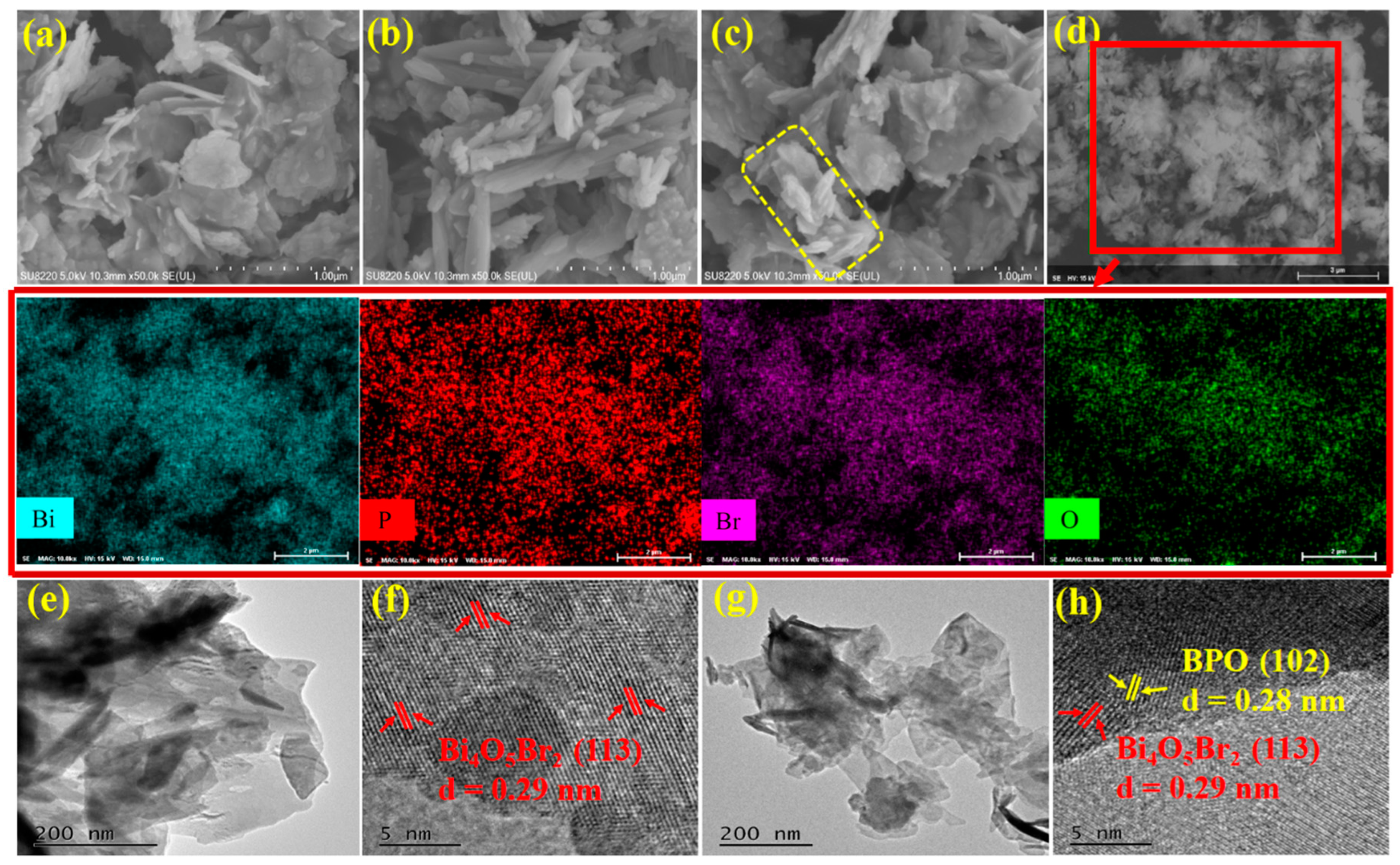

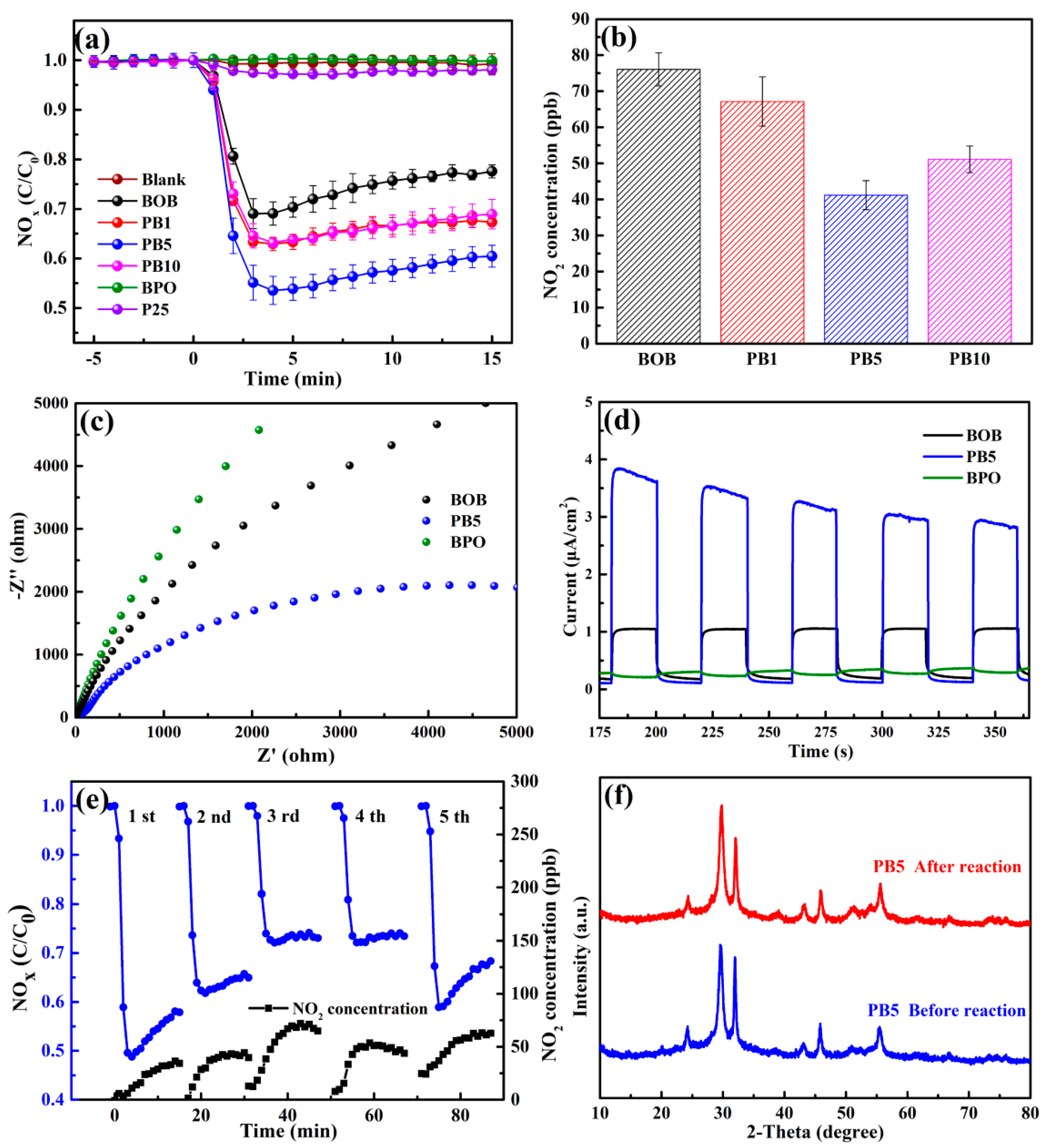
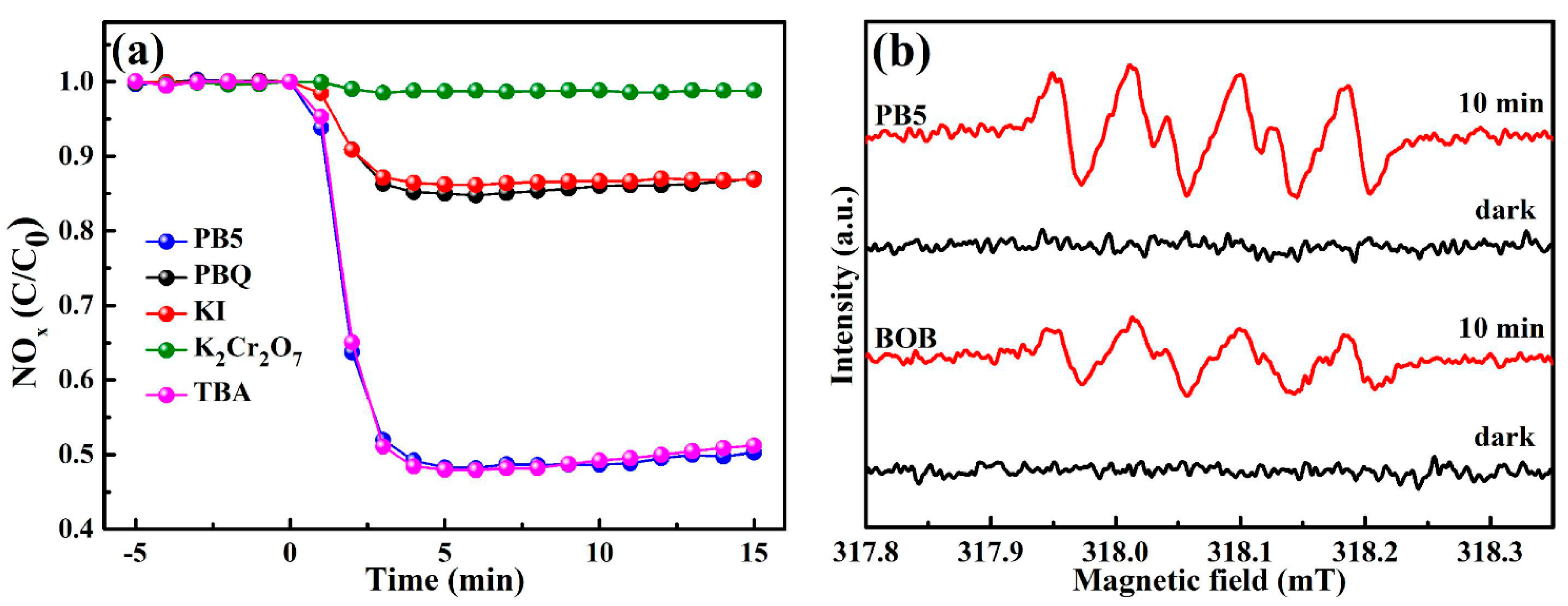
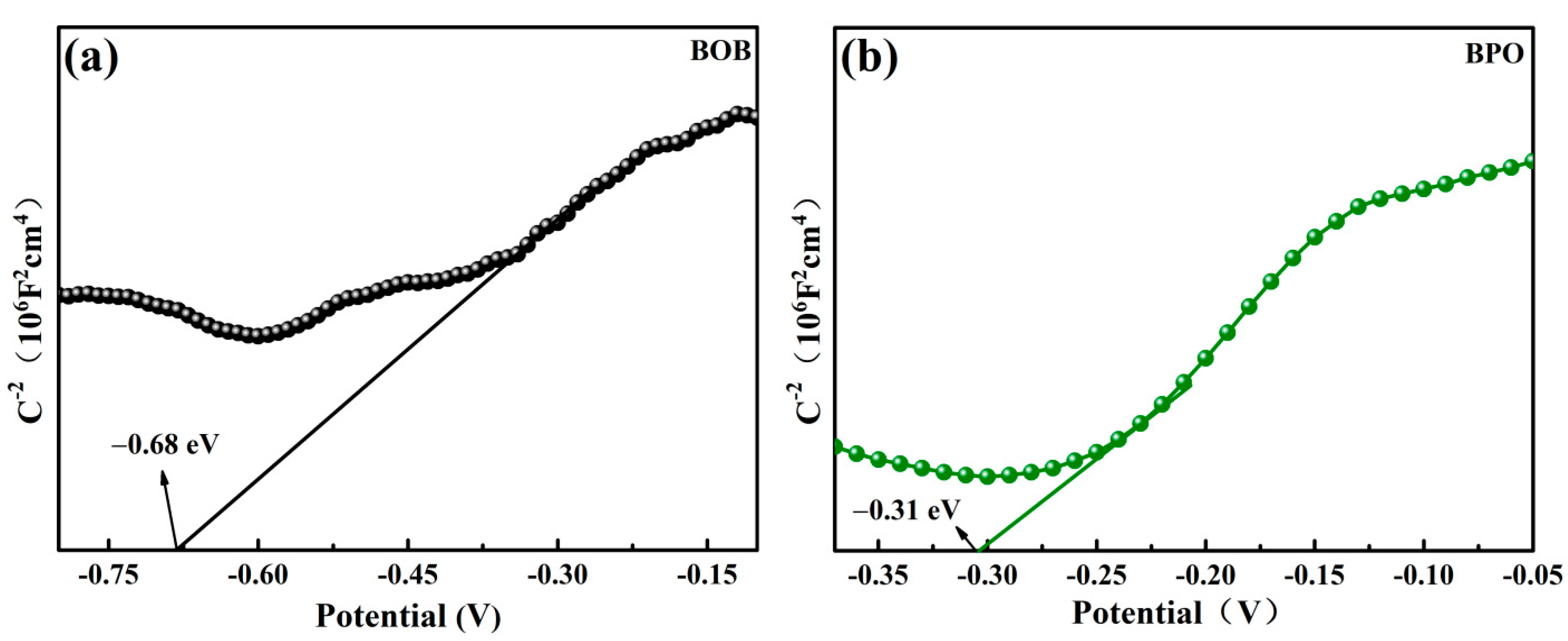
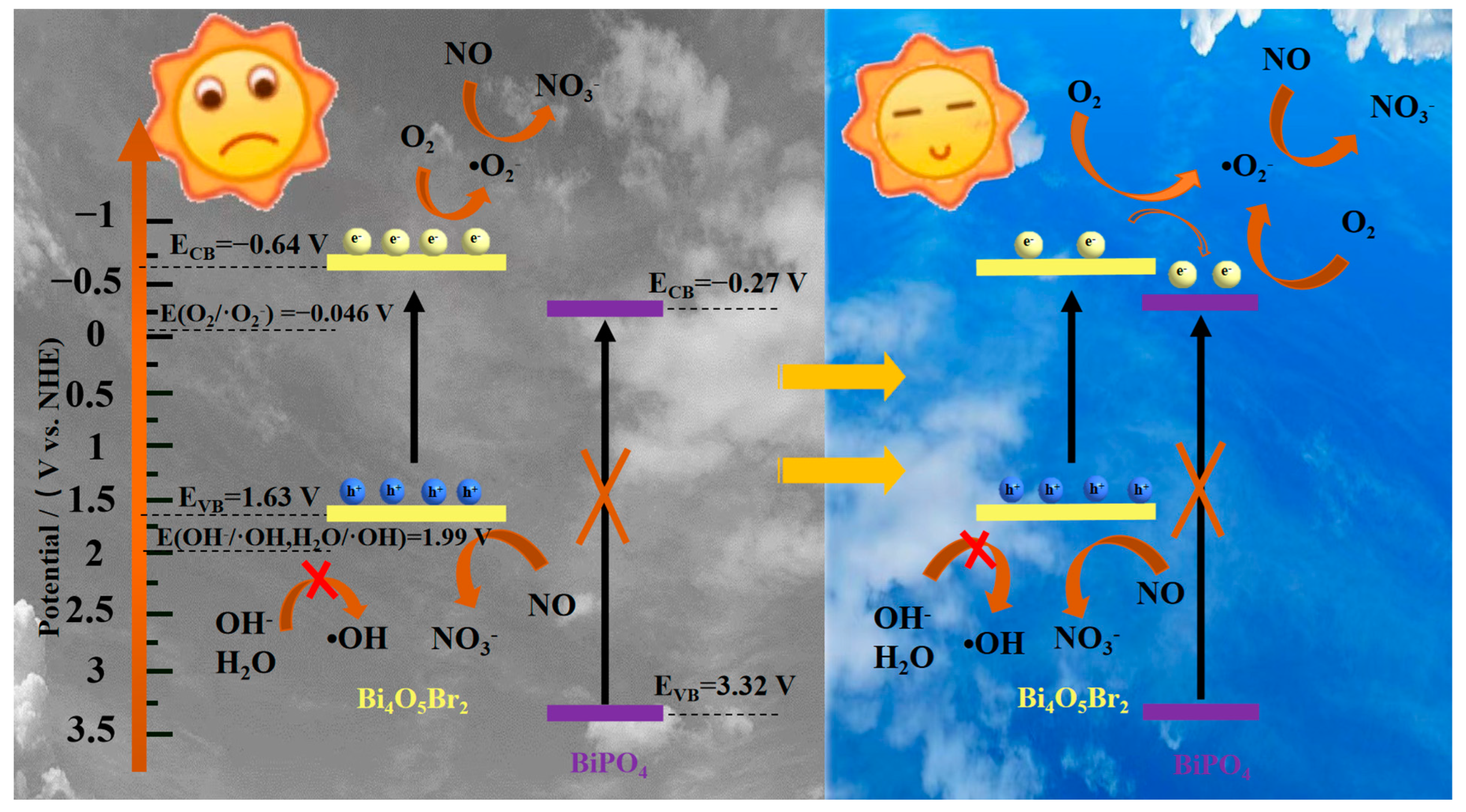
Publisher’s Note: MDPI stays neutral with regard to jurisdictional claims in published maps and institutional affiliations. |
© 2022 by the authors. Licensee MDPI, Basel, Switzerland. This article is an open access article distributed under the terms and conditions of the Creative Commons Attribution (CC BY) license (https://creativecommons.org/licenses/by/4.0/).
Share and Cite
Chang, F.; Shi, Z.; Lei, Y.; Zhao, Z.; Qi, Y.; Yin, P.; Chen, S. The Strengthened Photocatalytic NOx Removal of Composites Bi4O5Br2/BiPO4: The Efficient Regulation of Interface Carriers by Integrating a Wide-Bandgap Ornament. Molecules 2022, 27, 8474. https://doi.org/10.3390/molecules27238474
Chang F, Shi Z, Lei Y, Zhao Z, Qi Y, Yin P, Chen S. The Strengthened Photocatalytic NOx Removal of Composites Bi4O5Br2/BiPO4: The Efficient Regulation of Interface Carriers by Integrating a Wide-Bandgap Ornament. Molecules. 2022; 27(23):8474. https://doi.org/10.3390/molecules27238474
Chicago/Turabian StyleChang, Fei, Zhuoli Shi, Yibo Lei, Zhongyuan Zhao, Yingfei Qi, Penghong Yin, and Shengwen Chen. 2022. "The Strengthened Photocatalytic NOx Removal of Composites Bi4O5Br2/BiPO4: The Efficient Regulation of Interface Carriers by Integrating a Wide-Bandgap Ornament" Molecules 27, no. 23: 8474. https://doi.org/10.3390/molecules27238474





